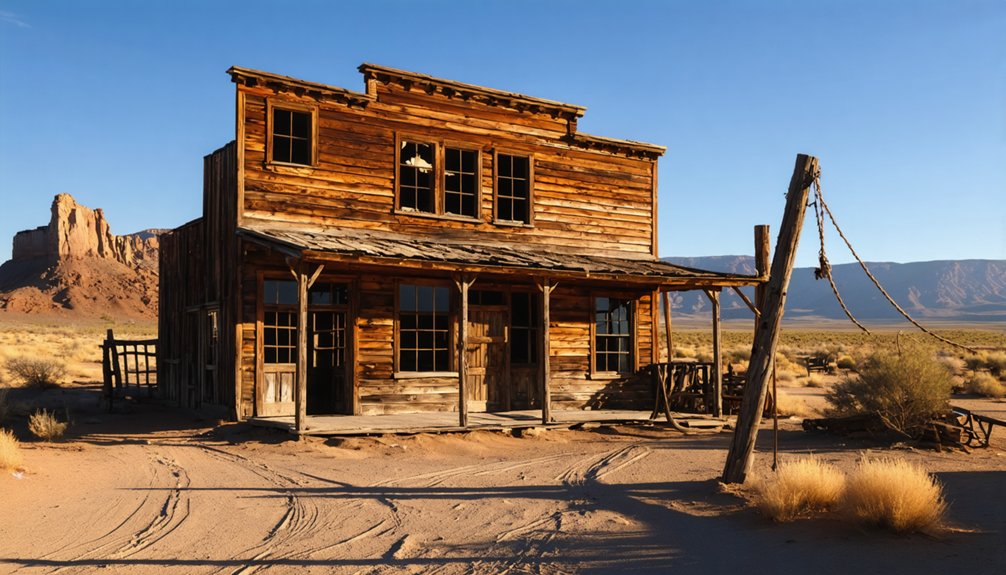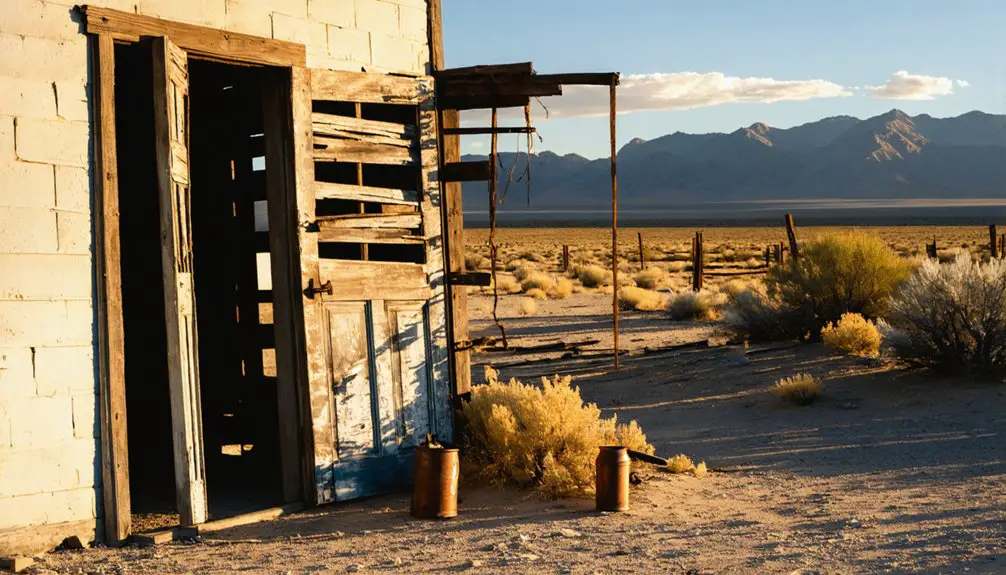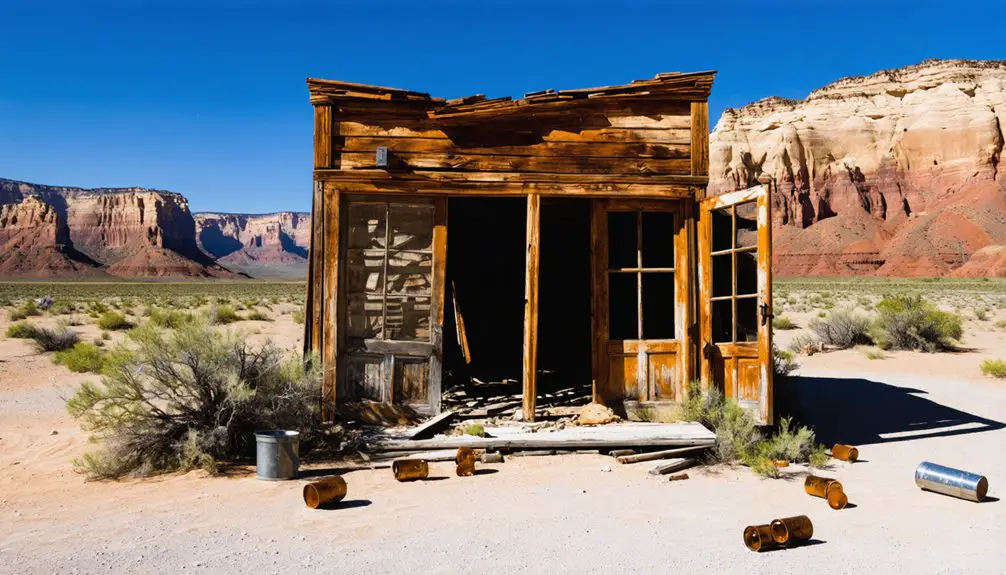You’ll find the remnants of Stateline, Utah nestled along the Utah-Nevada border in Stateline Canyon, where gold and silver discoveries sparked a boomtown in 1894. The town quickly grew to 300 residents with hotels, saloons, and stores serving the mining community. While the mining operations declined by 1918, stone buildings still stand as silent witnesses to this once-thriving frontier settlement. The canyon’s rich history holds fascinating tales of miners, outlaws, and cross-border commerce.
Key Takeaways
- Stateline was a gold mining boomtown established in 1894 after rich ore strikes in Utah’s Stateline Canyon.
- The town peaked with 300 residents, featuring hotels, saloons, and stores during its 1894-1918 mining heyday.
- Mining operations included 14 underground mines producing gold and silver, employing 180 men during peak production.
- Located on the Utah-Nevada border, the town served as both a legitimate mining community and route for cattle rustlers.
- Today, only stone building ruins remain as evidence of the once-thriving mining community that declined by 1918.
Striking Gold: The Birth of a Frontier Town
While gold discoveries in Utah began as early as 1858 at Gold Hill in Tooele County, the story of Stateline wouldn’t unfold until decades later when prospectors struck rich ore in Stateline Canyon in 1894.
The frontier spirit ignited in 1896 when the Ophir mine revealed exceptionally rich deposits, sparking a localized gold rush that transformed the canyon from wilderness to boomtown. The discovery sparked renewed interest in mining after the fixed gold price of $20.67 per ounce had previously limited mining activities. Like many mining areas across Utah, European immigrants were among the early arrivals seeking their fortunes.
You’d have found town lots selling for $100 as prospectors and fortune-seekers flocked to the area.
By 1903, Stateline had grown into a bustling community of 300 residents, complete with stores, a hotel, saloons, and its own newspaper.
The ore was so rich that you could pan gold directly from the mine dumps, proving the district’s remarkable wealth and drawing even more settlers to this promising frontier outpost.
Life in the Mining Boomtown
You’ll find Stateline’s early-1900s peak bustling with 300 residents, as mining operations employed 180 men and attracted merchants, blacksmiths, and other service providers to support the growing community.
The town’s two saloons, hotel, restaurant, and general stores created a vibrant commercial center where miners could spend their earnings and socialize after long shifts underground. A collection of stone buildings still stands as a testament to the town’s architectural legacy.
You can imagine the daily rhythm of frontier life as stagecoaches arrived from Modena, the Stateline Oracle newspaper shared local happenings, and the five major mines including the Ophir and Creole kept the town’s economy humming.
The discovery of gold and silver in 1894 led to the town’s establishment and rapid growth, though prosperity would last less than two decades.
Mining Drives Town Growth
After the discovery of rich gold and silver veins in 1896, Stateline quickly transformed from empty terrain into a bustling mining boomtown. Within just a few years, you’d find over 300 residents working the underground mines, where labor forces extracted high-grade ore ranging from 6 to 20 g/t gold. Early miners relied on steam-powered drilling and basic hand tools to extract the precious metals.
Mining techniques focused on shallow depths of 30-70 meters, though some operations reached 180 meters deep.
- 14 underground mines operated simultaneously at peak production
- Four mills processed the valuable ore extracted from the veins
- Local governance emerged to regulate mining claims and operations
- Skilled craftsmen built lasting stone structures throughout town
- Railroad connections enabled efficient transport of ore and supplies
The rapid development brought stores, hotels, saloons, and blacksmith shops – all essential services supporting the thriving mining community.
Daily Life and Commerce
The growth of mining operations sparked a vibrant commercial center in Stateline by 1903. You’d find two or three general stores, a hotel, and two saloons serving the 300 residents.
Daily routines centered around the blacksmith shop, where miners got their equipment repaired, and the shoemaker who kept workers’ boots in good condition. A restaurant and newspaper office added to the bustling main street. The State Line Oracle newspaper helped keep residents informed of local happenings. The Ophir mine operations provided steady work for most of the townspeople.
Community gatherings often happened at the saloons after long shifts, while the daily stagecoach brought fresh supplies and connected you to the railroad in Modena.
The town’s evolution from tent camps to proper wooden houses showed Stateline’s progress. By 1903, you could purchase a town lot for $100, joining the 17 established homes that housed miners and their families.
Social Events Unite Community
Despite lacking a formal place of worship, Stateline’s vibrant social life blossomed around a memorable 1903 Thanksgiving masquerade ball that drew residents from both sides of the Utah-Nevada border.
You’d find community resilience on display through cultural gatherings that united miners facing shared hardships and dangers. The town’s social fabric wove together through two bustling saloons, hotels, and restaurants where you could exchange stories and build connections. At its peak, 300 residents participated in these lively community gatherings. The town’s ball mill operations helped establish it as an important hub for local mining activities.
- Live music performances brightened both formal events and casual gatherings
- The Stateline Oracle newspaper kept everyone informed of local happenings
- Daily stagecoach service to Modena enabled broader social connections
- Two saloons served as essential meeting spots after long workdays
- Holiday celebrations helped maintain cultural traditions despite isolation
Business and Commerce Along the Border
You’ll find that Stateline’s prime location on the Utah-Nevada border served its commercial development well, as the town established crucial supply chains between the railroad station at Moda and local mining operations.
The business district featured multiple general stores, a hotel, and essential services like a blacksmith and shoemaker to support the mining community’s needs. At its peak, the town supported a population of three hundred citizens who relied on these businesses.
Cross-border commerce flourished as residents from both states freely moved between Stateline and neighboring Fay, Nevada, sharing social events and participating in regional trade.
Mining Town Supply Chain
Following Stateline’s gold and silver discoveries in 1894, an important supply chain emerged to support the town’s mining operations.
You’d find small-scale miners relying on a resource management system that brought vital supplies from nearby Modena via stagecoach and wagon routes.
- Explosives, tools, and mining equipment arrived regularly to support ore extraction
- Local milling operations processed minerals on-site until environmental regulations shut them down in 1984
- Daily stagecoach services guaranteed consistent delivery of supplies and movement of workers
- General stores served as primary supply chain hubs, stocking necessary mining gear and foodstuffs
- Cross-border commerce with Nevada created unique supply opportunities, though it also enabled some illicit trade activities
The town’s strategic location along the Utah-Nevada border shaped its supply dynamics, creating both challenges and advantages for mining operations.
Border Trade Benefits
While positioned along the Utah-Nevada border, Stateline capitalized on its unique location to foster a thriving cross-border economy from 1894 to 1918.
You’d find general stores, saloons, and hotels catering to miners and travelers moving between states, creating a bustling commercial hub that served both legal and underground trade networks.
The town’s strategic position enabled a complex cross border economy where cattle trafficking merged with legitimate commerce.
Nevada officials often turned a blind eye to Mormon cattle entering their territory, helping feed hungry mining camps.
Stateline Canyon’s trade routes connected Utah towns like Frisco and Milford to Nevada’s mining regions, while social gatherings like the annual Thanksgiving masquerade ball doubled as informal marketplaces where goods and services changed hands across state lines.
General Stores and Services
During its peak years around 1903, Stateline’s commercial district buzzed with two to three general stores serving a population of roughly 300 residents.
You’d find these stores stocked with essential mining supplies, food staples, and daily necessities crucial for survival in this remote canyon settlement. The stores anchored a thriving business district where community interactions flourished alongside hotels, saloons, and skilled trades.
- Blacksmiths and shoemakers provided critical services for miners
- A fine hotel welcomed visitors and temporary workers
- Daily stagecoach service connected you to Modena
- Local restaurants served hot meals to residents and travelers
- Multiple saloons offered spaces for both business deals and socializing
These general store supplies and services helped sustain both commerce and daily life until declining ore production gradually emptied the town.
Social Events and Entertainment
Despite its remote frontier location, Stateline maintained a vibrant social scene centered around its 1903 Thanksgiving masquerade ball. You’d find residents from Stateline and neighboring Fay, Nevada gathering for this festive tradition, which filled the void left by the absence of local churches.
Live music enhanced these community gatherings, offering a cultural escape from the harsh mining life.
The town’s social infrastructure included several saloons, a hotel, and general stores where you could connect with fellow residents. Daily stagecoach service to Modena kept you linked to the outside world, while blacksmith and shoemaker shops served as informal meeting spots.
However, as the mines played out after 1905, the once-thriving social scene gradually disappeared, marking Stateline’s shift toward its ghost town status.
Outlaws and Cattle Rustling

Beyond the social gatherings and masquerade balls, Stateline harbored a darker side centered around cattle rustling and outlaw activity.
You’ll find that during the mining boom of the 1890s, cattle rustlers frequently used Stateline Canyon to move stolen Mormon cattle across state lines into Nevada. The remote terrain and Nevada’s lenient stance on stray cattle created perfect conditions for outlaws like Nate Hansen, who met his fate at the hands of an angry Mormon posse near the state line.
- Mormon cattle thieves could quickly cross into Nevada’s mining camps to sell stolen livestock
- The canyon’s rugged landscape provided natural cover for outlaw operations
- Local saloons served as gathering spots for outlaws mingling with miners
- Mormon posses actively pursued rustlers, often leading to violent confrontations
- The outlaw legacy remains a defining chapter in Stateline’s ghost town history
The Decline of Mining Operations
As high-quality ore deposits began to dwindle around 1910, Stateline’s once-thriving mining operations entered a steep decline.
By 1918, you’d find only 18 people still working small claims, as ore profitability couldn’t sustain larger operations. While some mining persisted into the 1930s and ’40s, it never regained its former glory.
The final chapter of Stateline’s mining story came in 1984 when the Ophir mill shut down due to stricter mining regulations and environmental compliance issues.
The EPA’s involvement marked a definitive end to organized mining in the area.
Today, you’ll see only remnants of the town’s mining heritage – partially preserved stone structures and ruins that tell the tale of this typical Utah boom-and-bust mining community.
Exploring the Ghost Town Today

Today’s visitors to Stateline will find a haunting collection of stone walls, old homes, and rusted mining equipment spread along a mile-long stretch of what was once a bustling frontier town.
The 2020 fire left its mark, but you’ll still discover plenty to explore. While current accessibility requires a capable vehicle on rough roads, the site’s weekend visits offer a remarkable glimpse into mining history.
Despite the scars of wildfire, Stateline’s rugged trails and weathered ruins welcome weekend adventurers seeking glimpses of the mining frontier.
- Metal detect around charred buildings for hidden artifacts
- Peer into secured mine shafts protected by metal grids
- Visit the well-maintained cemetery for historical reflection
- Navigate the State Line Trail by ATV or off-road vehicle
- Photograph burnt structures against the rugged wilderness backdrop
The ghost town’s remaining features, though fire-scarred, continue to tell stories of frontier life, mining operations, and the pioneering spirit that once thrived here.
Historic Structures and Preservation
While many frontier mining towns have vanished without a trace, Stateline’s historic structures still tell the story of its 1894-1918 heyday.
You’ll find standing walls, partially intact homes, and a prominent chimney marking where 300 residents once lived. The town’s structural integrity took a hit in 2020 when fire swept through, leaving many buildings charred but still standing.
Despite minimal historic preservation efforts, you can explore remnants of the town’s mining past, including old equipment and secured mine shafts covered by metal grids.
The well-maintained cemetery offers a peaceful connection to former residents. While most structures remain in their weathered state, they provide authentic glimpses into early 20th-century mining life along the Utah-Nevada border.
Frequently Asked Questions
What Indigenous Tribes Originally Inhabited the Stateline Canyon Area?
You’ll find the Fremont people first inhabited Stateline Canyon until 1250 A.D., when Native tribes like the Ute, who’ve always called Utah home, along with migrating Paiute and Shoshoni, shaped the area’s cultural heritage.
How Did Miners Survive the Harsh Winters in Stateline’s Remote Location?
You’d survive by building sturdy stone shelters against bitter winds, stockpiling preserved foods in fall, maintaining wood-burning stoves, wearing heavy wool layers, and working together with fellow miners during brutal winters.
Were There Any Major Accidents or Disasters in Stateline’s Mines?
While there’s no record of major mining accidents at Stateline itself, you’ll find nearby disasters like Scofield and Castle Gate shaped mine safety practices throughout Utah’s coal country.
What Happened to the Residents’ Belongings When They Abandoned the Town?
You’ll find their abandoned possessions were largely left behind, decaying under harsh elements or destroyed by fires. Some residents’ memories vanished as belongings were scattered by scavengers or deteriorated beyond recognition.
Did Any Famous People Ever Visit or Stay in Stateline?
You won’t find records of famous visitors or notable stays in Stateline. The only historically significant figure was local outlaw Nate Hansen, who operated there before being killed by a Mormon posse.
References
- https://www.youtube.com/watch?v=dCg_xiclHxA
- http://www.expeditionutah.com/forum/index.php?threads/ghost-town-stateline.4187/
- https://www.standard.net/lifestyle/recreation/2023/oct/05/atv-adventures-burnt-woods-and-ghost-towns-on-the-state-line-trail/
- https://www.youtube.com/watch?v=DkSv7sq_564
- https://history.utah.gov/event/modena-hebron-stateline-ghost-towns/
- https://geology.utah.gov/popular/rocks-minerals/utah-gold/
- https://www.uen.org/utah_history_encyclopedia/m/MINING.shtml
- https://moabsunnews.com/2023/08/24/moab-history-135-years-since-the-discovery-of-gold-at-miners-basin-la-sal-mountains/
- https://dixie4wheeldrive.com/diamond_valley_state_line_mine_hackett_ranch_jenny_mine/
- https://westernmininghistory.com/library/156/page1/



